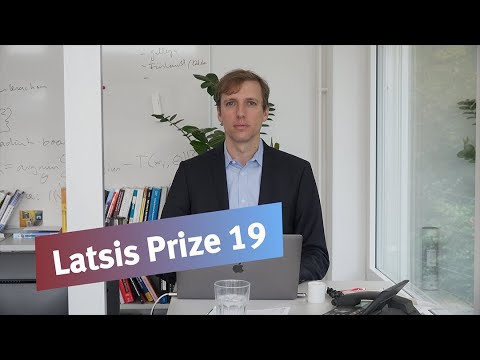Putting research to the real-world test
Dominik Hangartner, a political scientist at ETH Zurich, has received one of Switzerland’s most prestigious science awards. The National Latsis Prize has recognised the quality of Hangartner’s research on migration and its importance for public policy. We sat down with Hangartner to find out what drives him and what he finds so exciting about turning research into concrete policies.
Sometimes research is like going hiking. Whenever Dominik Hangartner embarks on a new trek, he selects his destination, saves the route on an app, and then strikes out into the unknown. This fondness for treading new paths also spills over into Hangartner’s research, where it joins ambition, persistence and the use of new statistical methods.
Hangartner is an Associate Professor of Public Policy at ETH. He says that a healthy mixture of patience and impatience characterises his personality and way of working, but it’s the impatience that drives him forward: he wants answers to his research questions, and he wants them now. “Scientific quality is something that needs time, however,” says Hangartner. “Basic research is a marathon, not a sprint.”
This kind of research requires patience and persistence until the results take shape. The initial assumptions then either crystallise into ironclad facts, or they break down in the face of empirical evidence and have to be discarded – at which point the journey begins anew. In the world of science, this can be just as edifying as staying on the same path.
Hangartner is fascinated by the tension that arises from the desire to have immediate answers and the slower-paced reality of conducting research: it’s one factor that drew him to a career in academia. He also relishes the challenge of putting research findings to the real-world test. “As a scientist I always want to go one step further,” says Hangartner. “This also means being able to translate my research results into actionable policies and testing if they actually work in the real world.”
Challenges in migration
Hangartner is not the type of academic who issues bold theories from the ivory tower. Rather, his approach to research often involves collaborations with governments, international organizations, and immigrant service providers. He analyses hard real-world data to shed new light on topics such as the economic and political impact of migration, asylum procedures and integration, and public attitudes towards immigration.
Some typical case studies from his research include the integration of refugees in local job markets, the effects of the asylum process, and the role of naturalization in immigrant integration. According to Hangartner, one fundamental challenge in this space is that scepticism towards immigration is increasing in many host countries while the push factors for migration show no signs of waning.
For this reason, Hangartner focuses on analysing how well laws and policies work, what effect they have, and how they can be re-designed for the benefit of migrants and their host communities. “Our knowledge should serve as the basis for innovative solutions in asylum and integration policy that improve the situation for as many people as possible,” he explains.
In just the past three years, he has authored various publications showing, for example, that lengthy asylum procedures and employment bans for refugees lead to higher social costs and a reduction in tax revenues.
Together with colleagues from Stanford, Hangartner developed a broadly applicable, data-driven algorithm for improving the geographic allocation of refugees. This algorithmic approach makes use of existing data to harness the synergies between refugees’ characteristics and host communities. This allows for refugees to be settled in regions where they have the best chances of finding employment.
The State Secretariat of Migration (SEM) is currently running a pilot study to test the effectiveness of this data-driven approach, and policymakers from the Benelux countries and Scandinavia have also shown interest in the method.
Our knowledge should serve as the basis for innovative solutions in asylum and integration policy that improve the situation for as many people as possible.Dominik Hangartner
Hangartner’s research also caught the attention of the Swiss National Science Foundation (SNSF), which has just awarded him the National Latsis Prize. The SNSF’s award recognises the exceptional quality of Hangartner’s research on migration and its translation into policymaking. The National Latsis Prize is one of the most prestigious science prizes in Switzerland and is awarded to researchers aged 40 and below.
For Hangartner, the prize serves as a form of appreciation for his team and an acknowledgement of his approach to research. “I already felt early on in my academic career that an empirical approach based on data and statistics was the right way to find answers for the hard questions in migration research and to design better solutions,” he says.
Researcher and football fan
The 38-year-old political scientist has enjoyed a rapid rise in academia, but the path to his current position was not always straightforward. Hangartner grew up in Lucerne, where he still holds season tickets for the local football team. While attending high school in Immensee, he was primarily interested in chemistry but then decided to study economics at university. He obtained his doctorate in political science, and it was during this time that he decided to focus on issues surrounding migration. As a child, he had seen classmates attempt to become naturalized Swiss citizens, only to have their applications rejected at the ballot box – a practice that changed following a federal court ruling in 2003.
Right after finishing his doctorate, he was awarded an assistant professorship at the London School of Economics, which is among the world’s foremost institutions for economics and social sciences. Following a year as a visiting professor at Stanford University in California, he was called back to Switzerland by ETH Zurich. Here he leads the Public Policy Group as well as the Immigration Policy Lab, which has branches at both Stanford and ETH.
When working as a teaching assistant, Hangartner already knew he wanted to pursue a career in academia. He received a solid introduction to the mathematic modelling of social behaviour during his time studying economics and sociology. Statistical methods continue to inform his research approach today. Of particular importance for his work are the rapidly growing areas of causal inference, machine learning, and the combination of the two in what is called causal machine learning. This method allows researchers to infer causal relationships from non-randomized data.
With machine learning, computers can now identify relationships within complex data sets where humans either wouldn't succeed or would be too slow. Examples include the aforementioned refugee placement algorithm and or novel methods to detect hiring discrimination. For the latter project, Hangartner is working together with other ETH researchers and using data from online recruitment platforms to monitor biases in hiring decisions.

